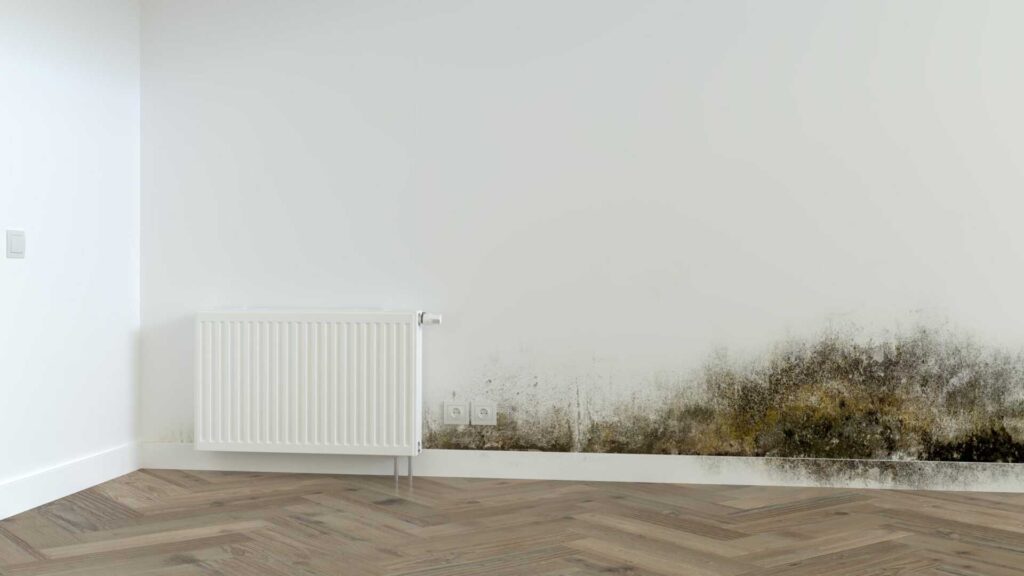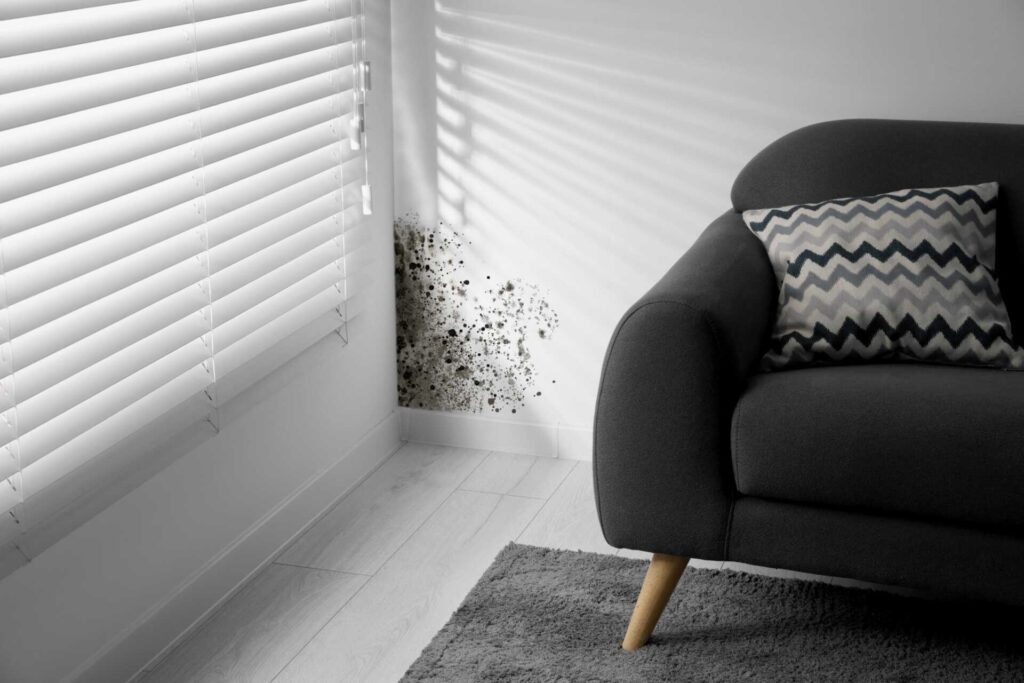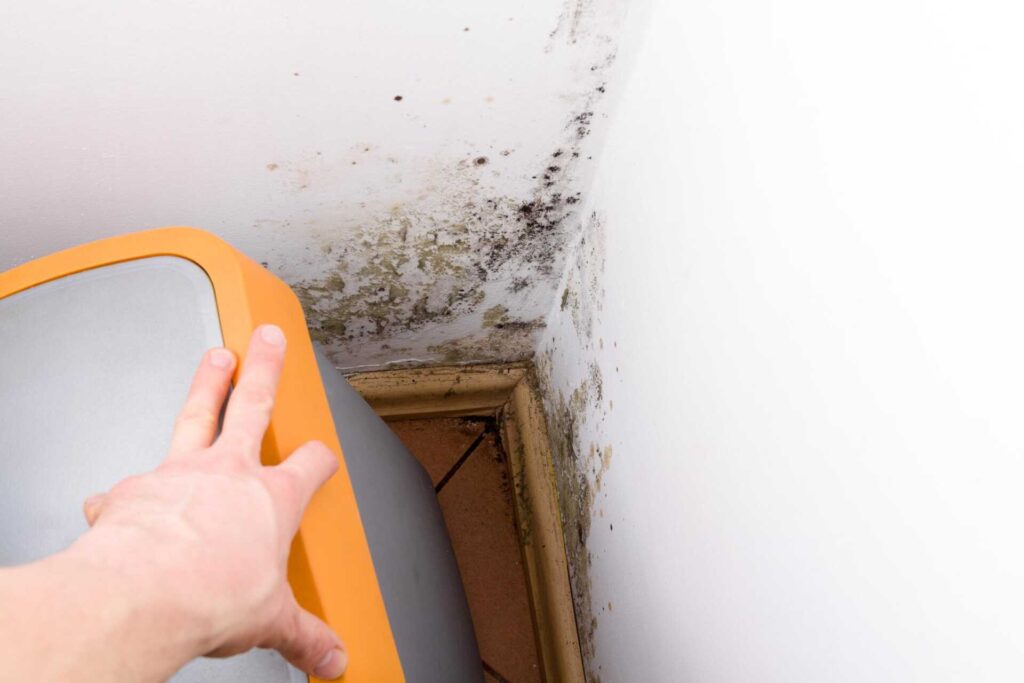
Contents
Water damage can be a silent predator, lurking in corners and crevices, ready to release mold’s destructive potential. To combat this threat effectively, it’s vital to act swiftly and strategically. By implementing the right measures, you can greatly reduce the risk of mold growth. What are the essential steps you should take to guarantee your space remains safe and dry? Let’s explore the best practices for mold prevention after water damage.
Key Takeaways
- Act swiftly to remove standing water and stop the source of water intrusion to minimize mold growth risk.
- Use fans and dehumidifiers to maintain humidity levels below 60% and promote faster drying.
- Clean and disinfect affected areas thoroughly using appropriate solutions to eliminate mold spores.
- Inspect and remove damaged materials like drywall and carpeting to prevent moisture retention and future mold growth.
- Consult professionals for comprehensive mold assessment and remediation to ensure safety and effective removal.
Act Quickly to Remove the Water
As soon as you notice water damage, it’s important to act quickly to remove the water. Delaying your response can lead to mold growth, which thrives in damp environments.
First, identify the source of the water intrusion and stop it if possible. Next, use pumps or wet vacuums to extract standing water. If the affected area is extensive, consider renting commercial-grade equipment designed for rapid water removal.
Once the bulk of the water is extracted, focus on drying surfaces. Remove soaked materials like carpets or drywall, as these can harbor moisture and facilitate mold development.
Make sure you’re wearing protective gear, such as gloves and masks, to safeguard against contaminants. Document the damage for insurance purposes, too.
Increase Air Circulation
To prevent mold growth after water damage, you need to increase air circulation in the affected area.
Use fans effectively to boost airflow and expedite drying.
Additionally, opening windows regularly helps to bring in fresh air and reduce humidity levels, further mitigating mold risks.
Use Fans Effectively
Using fans effectively can greatly enhance air circulation in your space, which is essential for preventing mold growth after water damage.
Position fans strategically to maximize airflow; place them near damp areas to help evaporate moisture quickly. Use multiple fans if possible, directing them towards windows or doorways to push the humid air outside.
Make certain that fans operate continuously for at least 24 to 48 hours to achieve ideal results. Consider using high-velocity fans, as they provide stronger airflow, which can considerably reduce humidity levels.
Regularly check the fans to confirm they’re functioning properly. By harnessing the power of fans, you create a drier environment, making it less conducive for mold to thrive and helping your community stay healthy.
Open Windows Regularly
Opening windows regularly is essential for increasing air circulation and reducing humidity levels after water damage. When you allow fresh air to flow through your space, you help evaporate moisture that could otherwise encourage mold growth.
Aim to open windows during dry, breezy days, as this maximizes airflow.
Consider cross-ventilation by opening windows on opposite sides of your home; this creates a direct path for air movement. Even if it’s just for a short period, this simple action can greatly lower indoor humidity.
Use Dehumidifiers
One effective way to combat mold growth after water damage is by employing dehumidifiers. These devices help lower humidity levels, making it harder for mold spores to thrive.
Here are three key benefits of using dehumidifiers:
Rapid Drying: Dehumidifiers extract moisture from the air, accelerating the drying process of affected areas.
Mold Prevention: By maintaining humidity levels below 60%, you greatly reduce the likelihood of mold growth.
Improved Air Quality: They help filter out allergens and pollutants, promoting a healthier living environment.
To maximize their effectiveness, position dehumidifiers in the most water-damaged areas and run them continuously until humidity levels stabilize.
Regularly empty the water reservoir or, if possible, use a continuous drainage option.
Clean and Disinfect Affected Areas
To effectively prevent mold growth after water damage, it is crucial to clean and disinfect the affected areas thoroughly. Start by using a mixture of water and a suitable disinfectant, like bleach or a commercial mold remover. Make certain you wear protective gear such as gloves and masks.
Here’s a quick guide to help you:
| Step | Action | Tips |
|---|---|---|
| Initial Cleaning | Remove visible dirt and debris | Use a damp cloth |
| Disinfection | Apply disinfectant solution | Follow manufacturer’s instructions |
| Drying | Use fans and dehumidifiers | Aim for below 60% humidity |
Remove Damaged Materials
Once you’ve cleaned and disinfected the affected areas, the next critical step is to remove damaged materials. This process is vital to prevent mold growth and guarantee a safe environment.
Here are three key components to focus on:
Drywall: If it’s soaked, cut it out and replace it. Mold can thrive in wet drywall.
Carpeting: Remove any carpet that’s been greatly affected by water. It’s often a breeding ground for mold.
Insulation: Any insulation that’s been compromised should be taken out. Wet insulation won’t dry out effectively and can retain moisture.
Seal Leaks and Gaps
After removing damaged materials, sealing leaks and gaps becomes imperative to prevent future water intrusion and mold growth.
Start by inspecting your property thoroughly for any cracks or openings in walls, ceilings, and foundations. Pay close attention to areas around windows, doors, and plumbing fixtures, as these are common entry points for water.
Use high-quality caulk or sealant to fill small gaps and cracks, ensuring a tight seal. For larger openings, consider using expandable foam insulation or weatherstripping.
Don’t forget to check your roof and gutters, as leaks here can lead to considerable water issues. Make necessary repairs or consult a professional if needed.
Regularly inspect these areas, especially after heavy rains or storms, to maintain your property’s integrity.
Monitor Humidity Levels
Maintaining ideal humidity levels is essential for preventing mold growth after water damage.
Keeping humidity in check not only protects your home but also fosters a healthier living environment.
Here are three key strategies to monitor and manage humidity:
Use a Hygrometer: Invest in a Hygrometer to measure humidity levels accurately. Aim for a range of 30-60% for favorable conditions.
Ventilate Properly: Open windows and use exhaust fans in high-moisture areas, like kitchens and bathrooms, to promote airflow and reduce humidity.
Dehumidifiers: Consider using dehumidifiers in damp areas to remove excess moisture. Regularly empty the water reservoir to maintain efficiency.
Utilize Mold-Resistant Products
To effectively combat mold growth after water damage, you should choose mold-resistant materials for your repairs and renovations.
These products, such as mold-resistant drywall and paints, can greatly reduce the risk of mold development.
Additionally, applying protective coatings on surfaces can enhance their resistance to moisture and mold proliferation.
Choose Mold-Resistant Materials
Choosing mold-resistant materials is essential if you want to prevent mold growth in areas affected by water damage. By selecting the right products, you can greatly reduce the risk of mold proliferation.
Here are three key materials to keep in mind:
Mold-Resistant Drywall: This type of drywall is treated to resist moisture and inhibit mold growth.
Water-Resistant Flooring: Options like vinyl or tile can withstand moisture better than traditional wood or carpet.
Mold-Resistant Paint: Using paint with antimicrobial properties helps protect surfaces from mold spores.
Incorporating these materials into your restoration efforts promotes a healthier environment and enhances your space’s longevity.
Prioritize mold-resistant products to create a safe and welcoming home.
Apply Protective Coatings
Applying protective coatings is an essential step in safeguarding your home against mold growth following water damage. These coatings, often mold-resistant paints or sealants, create a barrier that prevents moisture absorption in walls and surfaces.
When choosing a product, look for those specifically labeled as mold-resistant, as they contain fungicides that inhibit mold development.
Before application, verify the surface is clean and dry to maximize adhesion and effectiveness. Apply the coating evenly, following the manufacturer’s instructions for best results.
Regularly inspect these areas for wear and reapply as necessary to maintain protection. By utilizing mold-resistant products, you greatly reduce the likelihood of mold returning, guaranteeing a healthier environment for you and your loved ones.
Regularly Inspect for Signs of Mold
Mold can thrive in damp environments, making regular inspections essential for preventing its growth after water damage.
To keep your space mold-free, focus on these key areas:
Basements and Crawl Spaces: Check for leaks, moisture, or condensation. These areas are often overlooked but can harbor mold quickly.
Bathrooms: Inspect tiles, grout, and caulking for signs of mold. High humidity makes these spaces particularly susceptible.
Walls and Ceilings: Look for discoloration or water stains, which may indicate hidden mold growth.
Consult Professionals for Remediation
When facing mold after water damage, consulting professionals for remediation is essential.
Experts can provide a thorough assessment to identify the extent of the damage and recommend effective remediation techniques tailored to your situation.
Their specialized knowledge ensures that the mold is removed safely and efficiently, preventing further issues.
Importance of Expert Assessment
While it might be tempting to tackle mold issues on your own after water damage, consulting professionals for remediation is crucial. Their expertise guarantees thorough assessment and effective solutions.
Here are three key reasons to seek professional help:
Accurate Identification: Experts can identify hidden mold sources and assess structural damage that you might overlook.
Safety Measures: Professionals understand safety protocols for handling mold and minimizing health risks for you and your family.
Comprehensive Solutions: They offer tailored remediation plans, addressing the root cause to prevent future mold growth.
Effective Remediation Techniques
Addressing mold after water damage requires a strategic approach that professionals are trained to implement. When mold develops, it’s crucial to consult a remediation expert who can assess the situation accurately.
Professionals utilize advanced equipment like moisture meters and thermal imaging to identify hidden mold. They’ll contain the affected area to prevent spores from spreading, ensuring your home remains safe.
Using specialized cleaning agents, they’ll remove mold from surfaces and employ air scrubbers to filter out airborne spores. Additionally, they can address underlying moisture issues, such as leaks or inadequate ventilation.
Final Thoughts
Don’t let mold take hold after water damage; your home and health depend on it. By acting quickly and following these essential steps, you can safeguard your space. But remember, mold can be insidious, lurking in hidden corners. Regular inspections and proactive measures are your best defense. The longer you wait, the more extensive the damage may become. Stay vigilant, and don’t hesitate to consult professionals if you suspect a problem—your peace of mind is worth it.

